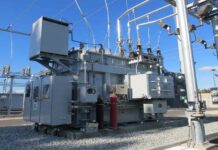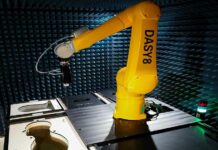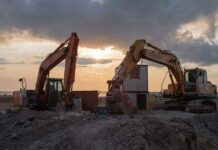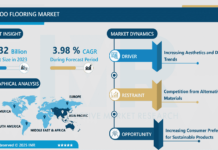The heavy construction equipment market is poised to witness a massive revolution with the mounting worldwide demand for sophisticated machinery. This report offers detailed analysis of the evolving dynamics of earthmoving equipment, material handling machinery, and heavy vehicles, presenting a comprehensive analysis of market forecasts up to 2030. The industry is anticipated to observe growth, boosted by massive investment in construction and infrastructure and growth in technology. The outlook predicts growth from USD 224.49 billion in 2025 to USD 286.51 billion in 2030, at 5.0% compound annual growth rate.
Growth Catalysts: Infrastructure and Technological Advances
The major driver of the expected growth is the rising need for heavy construction equipment for mining and world infrastructure projects. Asia-Pacific regions, spearheaded by nations such as China and India, have become the most dominant. The area is expected to record a compound annual growth rate of 5.2% based on high investments in large-scale construction schemes and expansion of mining activities. For instance, China will spend a total of about USD 1 trillion in state-led infrastructure projects, including urban roads, water pipeline networks, and large reservoir projects. By 2035, China plans to construct 70,000 kilometres of high-speed rail, significantly increasing the demand for heavy machinery.
In a similar vein, Europe has increased its investments, with the European Union pledging more than USD 5.4 billion towards transport infrastructure projects that include 135 development initiatives. The strategic investments are driving the adoption of advanced machinery, thereby generating profitable opportunities within the heavy construction equipment market.
Advancements in Propulsion and Equipment Types
Though the conventional diesel-engine machines remain the most dominant forces in the sector, there is a visible movement towards new-fangled alternatives like CNG, LNG, RNG, and battery-powered equipment, which are slowly gaining traction. The use of electrification and digitisation in heavy machinery is a key trend among manufacturers, geared towards adhering to environmental standards and increasing efficiency.
Leading companies like Caterpillar, Komatsu, Liebherr AG, and Hitachi Construction Machinery are pioneering advancements by incorporating AI and machine learning technologies into their machinery. Through the use of predictive analytics, organisations are now able to oversee machinery health from a distance, reduce downtime, and address operational risks effectively.For instance, Hitachi’s ConSite Mine platform leverages IoT technologies to deliver continuous analytics on mining equipment, facilitating predictive maintenance and enhancing operational efficiency.
Challenges: Regulation and Electrification
While the growth trend appears optimistic, the industry is confronted by a sequence of challenges. Harsh regional legislation against environmental emissions and safety standards is challenging for producers. Compliance with EU emission regulations, for instance, requires extensive environmental analysis and technical analysis, increasing the complexity and cost of machinery production.
Electrification, while revolutionary, comes with its own set of challenges. Battery-powered heavy equipment is also threatened by limited energy storage, long recharging times, and thermal management challenges. The manufacturers are still grappling with a significant challenge of finding the optimal balance between increasing battery capacity while minimizing weight and expense. Organisations are continuously investing huge amounts of resources in research and development efforts to overcome these challenges through the design of complex battery thermal management systems and light-weight materials.
Opportunities: Digitization and Autonomous Systems
The digitalization of services brings high potential for the heavy construction equipment sector. The sector is implementing sophisticated technologies, from telematics and intelligent applications to autonomous heavy equipment, to enhance productivity and safety. The fusion of Internet-enabled devices and artificial intelligence-based analytics is revolutionizing construction sites, allowing real-time monitoring and enabling accurate execution of projects.
Autonomous machinery is proving to be a transformative force. Organisations are implementing autonomous bulldozers, cranes, and trucks that function continuously in challenging environments, leading to decreased labour expenses and enhanced productivity. These innovations reflect a significant movement towards sustainable development, with nations across the globe committing resources to green infrastructure and clean energy initiatives.
Regional Analysis: Asia-Pacific Dominates the Market
The Asia-Pacific area continues to dominate the market with the impetus provided by rapid urbanization, rising population, and massive infrastructure projects. Regional governments are working hard at sustainable development agendas, which include investment in lithium mining for use in battery manufacture. China and India drive these developments forward with phenomenal heavy construction equipment adoption levels.
North America and Europe are equally crucial, with a focus on the modernization of aged infrastructure. The United States has invested substantial funds into widening its highways, while Europe is investing heavily in transport and energy projects to meet its sustainability targets.
Market Dynamics
Market leaders such as Caterpillar from the U.S., Komatsu from Japan, Volvo Group from Sweden, and Liebherr AG from Germany maintain their industry dominance through sustained innovation and strategic collaborations. These corporations are expanding their product lines to include electric-powered and autonomous equipment, as well as maintaining compliance with evolving regulations and market demands.
New Chinese and Indian players such as SANY Heavy Industry and XCMG Group are using cost benefits and local demand to gain more market power. Collectively, these companies are key to shaping the dynamic and competitive character of the heavy construction equipment market.
The Road Ahead
In the future, the heavy construction equipment market is set to experience massive growth fueled by strong investment in infrastructure, technological innovation, and growing demand for green solutions. The intersection of advanced technologies like IoT, AI, and autonomous systems is likely to transform operational efficiency and encourage environmental sustainability in the market.
However, the sector is also beset with issues of compliance with regulations, electrification, and lack of trained manpower. These problems need to be tackled through sagacious R&D investments, governmental support, and co-partnership among all stakeholders.
As economies across the globe have shifted their attention to infrastructure development as an economy growth driver, the heavy construction equipment market will remain a primary driver of this shift. The smart city revolution and renewable energy project revolution are transforming the construction landscape, making it more efficient, sustainable, and technologically advanced.
Reference:
https://www.globenewswire.com/news-release/2025/04/15/3061539/28124/en/Heavy-Construction-Equipment-Industry-Report-2025-Earthmoving-Material-Handling-Heavy-Vehicles-Market-Forecasts-to-2030.html




























